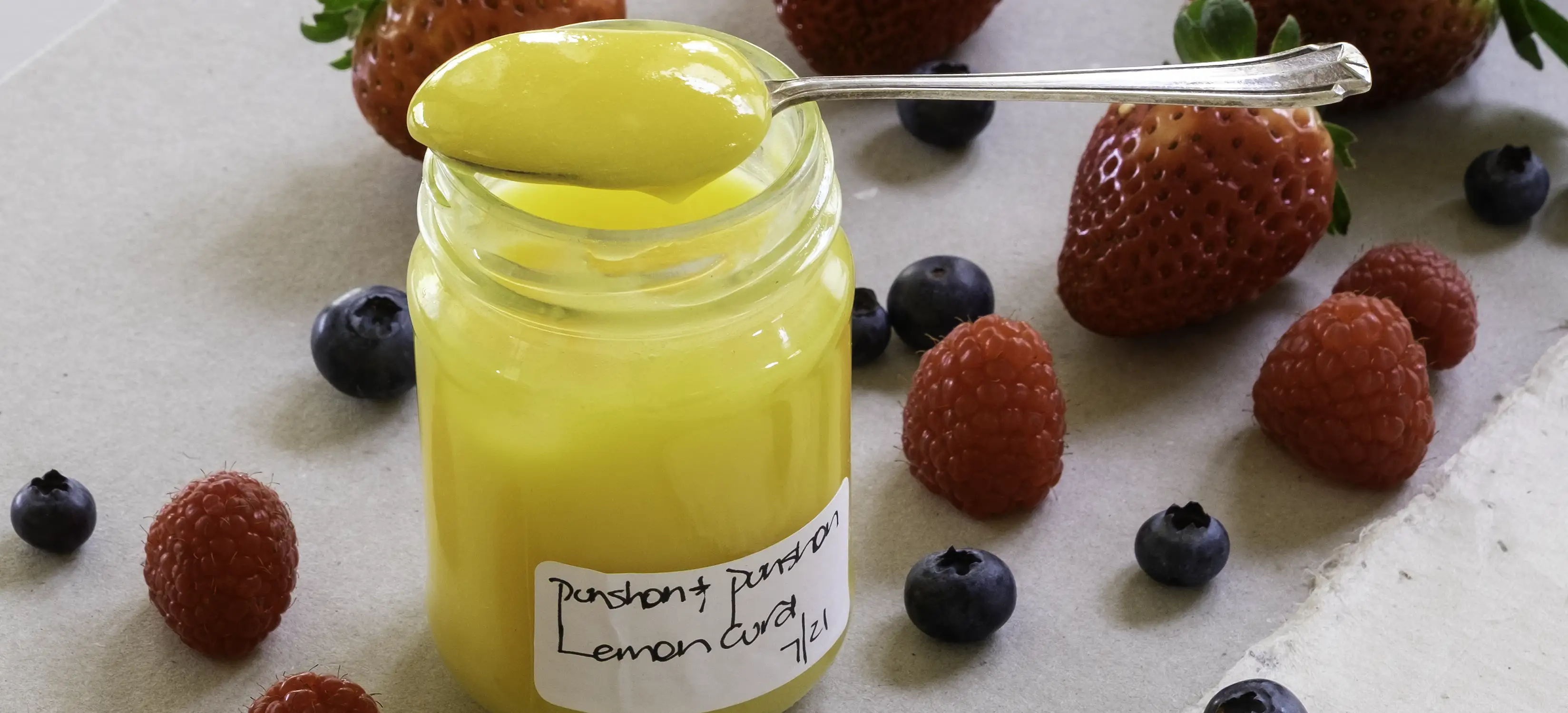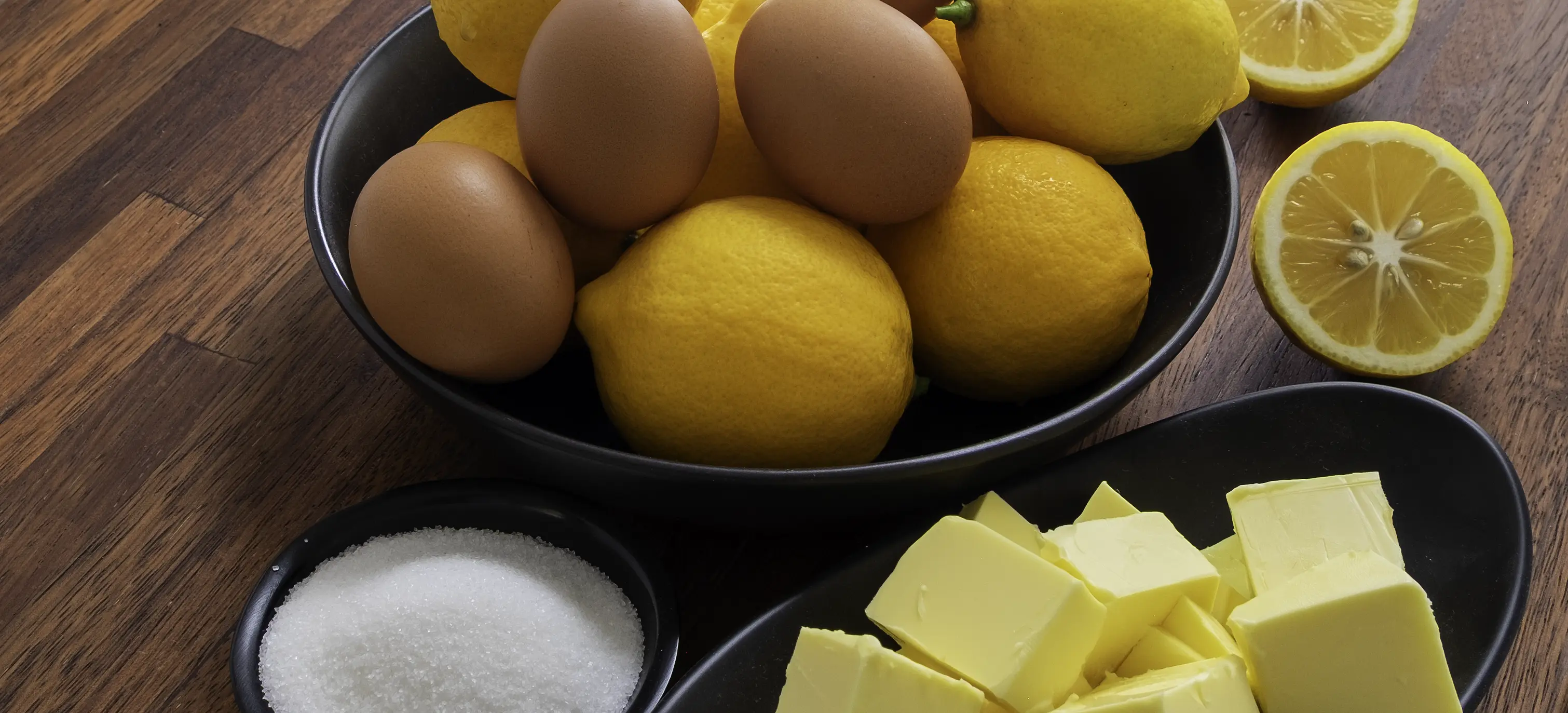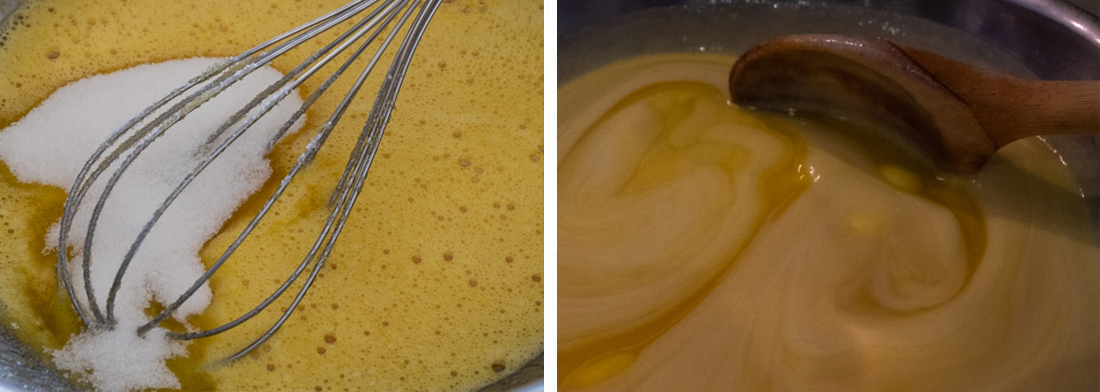Lemon Curd
- Fruit Cheeses, Butters & Curds

Smooth, luscious, and spreadable, a spoon of lemon curd is a spoonful of heavenly deliciousness. It captures the colour and flavour of the season. The combination of butter, eggs, sugar, and lemon juice creates an irresistible velvety preserve. Every time the jar is opened, endless possibilities abound to transform the ordinary into the extraordinary.
Spoon over fresh berries, yogurt, or ice-cream. Incorporate into pastry shells for a quick and easy lemon curd tart. Fill choux pastry for an indulgent lemon curd eclair with dark or white chocolate icing or use as a cake filling. Spread on pancakes, waffles, or your favourite toast. Serve with pancakes or scones and cream. Be totally indulgent, dip a clean teaspoon into the jar, and eat straight from the spoon. An opened jar never lasts long.
Over winter, when the lemons are prolific, make some lemon curd for yourself and those special ones in your inner circle. Fruit curd is sometimes called fruit butter because of its spreadability but technically this isn't correct.Traditional fruit butter is made from sieved fruit and cooked with sugar until set. Having a softer consistency than fruit cheese, it can be spread on bread and butter and used in a similar way to jam. Rarely made today or commercially available, traditional fruit has virtually disappeared.
- Preparation Time:
- 30 minutes
- Cooking Time:
- 35 minutes
PREPARATION
Sterilise glass jars and have the them hot, dry, and ready for the bottling stage.
Cut out wax paper discs to fit inside the preserving jars.

INGREDIENTS
- 250 ml
- Lemon juice, strained
- 2 teaspoons
- Lemon zest
- 400g
- White sugar
- 230g
- Unsalted butter
- 4
- Whole eggs, large
- 4
- Egg yolks, large

METHOD
Lemon curd is cooked in a double boiler, or in a heat resistant bowl over a pan of gently simmering water. My top 3 tips for successful curd are (1) strain the egg mixture, (2) keep stirring the mixture while it 's cooking and (3) never let it boil. For a more detailed explanation on how to make the perfect curd, refer to my article, Culinary Curd Capers
Wash the lemons to remove and gardens and shop dust or debris to prevent it from contaminating the mixture. Zest lemons for 2 teaspoons. Cut the lemons in half across the diameter and juice.
Strain and place into the bowl or the double boiler insert. Place over a saucepan of gently simmering water and add the sugar, butter and zest.
Stir gently until the sugar and butter have completely dissolved.
Place the whole eggs and egg yolks in a separate bowl and gently whisk until they are thoroughly combined. No egg white should be visible in the mixture.
Strain into the lemon mixture and stir constantly over the heat until the curd thickens and lightly coats the back of a wooden spoon. Alternatively, insert a digital thermometer into the mixture and cook until it reaches 82 C (maximum), stirring constantly.
Remove from the heat and continue to stir for a few moments as the curd will continue to cook and thicken.
Using a funnel and ladle pour into warm dry sterilised jars. Fill to the brim - it shrinks and thickens as it cools. Completely cover the surface with melted paraffin wax and seal with transparent cellophane discs. Refer to my article Sealing Jars with Paraffin Wax for a step-by-step explanation.
Label and store in the fridge.
Use within 6 weeks and check regularly for any contamination or mould.
NOTES
 Cook the curd until it covers the back of a wooden spoon
Cook the curd until it covers the back of a wooden spoon
- To wash the fruit, I use a pair of Skrub’s vegetable gloves. A wonderful invention made of a slightly course material that magically scrubs fruit and vegetables with the greatest of ease. Easy to wash and dry, they are an indispensable item in my kitchen. Special thanks to my very dear friend Sue, who found them in a cookware shop. Alternatively, use a kitchen vegetable brush.
- Have warm sterilised jars and waxed discs cut to size and all ingredients weighed and ready before commencing. To make waxed paper discs, first make a template. Trace the bottom of the your preserving jar onto a piece of waxed paper. Cut out and test that it will sit neatly inside the jar on top of the curd. Adjust size to make sure it's a secure fit. Using this as your template, cut enough waxed paper circles for your batch. For a more detailed explanation on how to seal with paraffin wax refer to my article Sealing with Paraffin Wax.
- Unsalted butter is recommended when making fruit curds. Salter butter can be sued, but it will mar the flavour. Margarine can also be used, however the taste and texture will not be the same.
- Gently rolling the lemons across a hard surface breaks open the fruit membranes that contain the juice. This helps to release as much juice as possible.
- Straining the whisked egg mixture helps to remove any unbeaten egg white. If left in the mixture, during the cooking process, it will cook and leave a white streak in the final fruit curd.
- Lemon curds should always be made in a heat resistant bowl over a pan of gently simmering water. Also known as cooking over a double boiler, it disperses the heat gently across the bowl. This helps to thicken the egg mixture gently, without curdling, if it’s stirred continually. Do not allow the mixture to boil otherwise it will curdle, producing lemon flavoured scrambled eggs.
- Fruit curd is made from a high proportion of eggs and butter, which does not make it suitable for room temperature storage. It’s better to make small quantities and always, always store in the fridge. Use within 6 weeks. I must admit it doesn’t last that long at our place once the jar is open.
- Variations: Any citrus flavour, orange, blood orange, mandarin, tangelo, lime, grapefruit, or passionfruit

